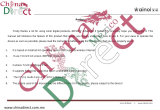
i
Chapter 1. Getting to know your computer ..................................................................................... 1
Top view ......................................................................................................................................................... 1
Left-side view ................................................................................................................................................ 8
Right-side view............................................................................................................................................ 10
Front view .................................................................................................................................................... 12
Rear view...................................................................................................................................................... 13
Chapter 2. Starting to use Windows 8............................................................................................14
Configuring the operating system for the first time .............................................................................. 14
Operating system interfaces ...................................................................................................................... 14
The charms .................................................................................................................................................. 15
Putting the computer to sleep or shutting it down ................................................................................ 17
Touch screen operation .............................................................................................................................. 19
Connecting to wireless LAN ..................................................................................................................... 23
Help and support ........................................................................................................................................ 24
Chapter 3. Lenovo OneKey Recovery System .............................................................................. 25
Chapter 4. Troubleshooting ............................................................................................................ 26
Frequently asked questions ....................................................................................................................... 26
Troubleshooting .......................................................................................................................................... 28
Trademarks....................................................................................................................................... 31
Contents




















